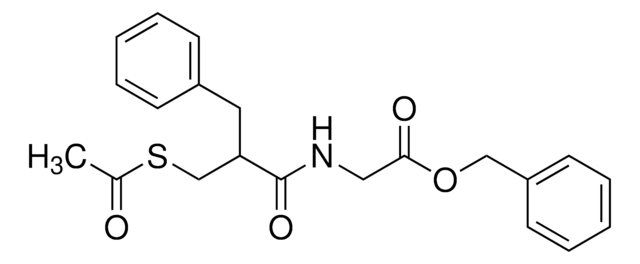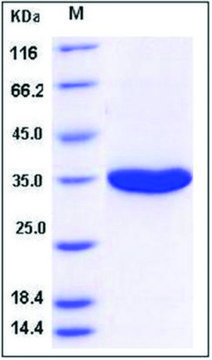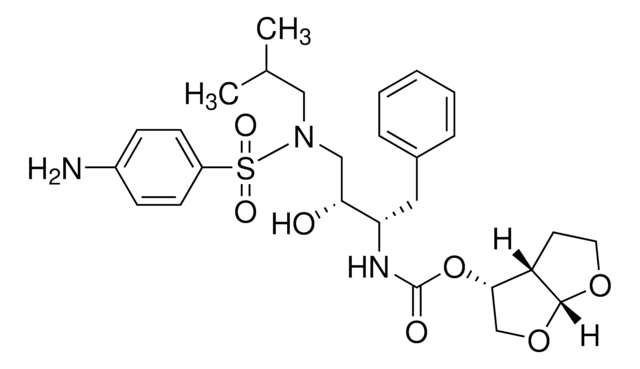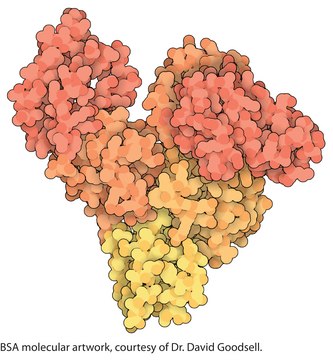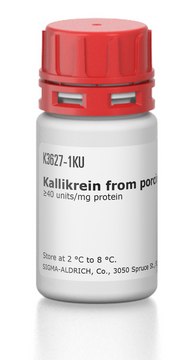SRP3159
SPARC/Osteonectin human
recombinant, expressed in CHO cells, ≥97% (SDS-PAGE), ≥97% (HPLC), suitable for cell culture
Sign Into View Organizational & Contract Pricing
All Photos(1)
Synonym(s):
BM-40, ON, Secreted protein acidic and rich in cysteine
UNSPSC Code:
12352200
NACRES:
NA.32
Recommended Products
biological source
human
recombinant
expressed in CHO cells
Assay
≥97% (HPLC)
≥97% (SDS-PAGE)
form
lyophilized
potency
0.5-0.7 μg/mL
mol wt
43.7 kDa
packaging
pkg of 50 μg
technique(s)
cell culture | mammalian: suitable
impurities
<0.1 EU/μg endotoxin, tested
color
white
UniProt accession no.
shipped in
wet ice
storage temp.
−20°C
Gene Information
human ... SPARC(6678)
General description
SPARC (secreted protein acidic and cysteine rich) is a multifunctional Ca2+-binding glycoprotein that belongs to the matricellular protein family, and is one of the eight members of the SPARC family. In adult animals, SPARC protein is generally expressed in remodeling tissues, such as bone, mucosa of the gut, and healing wounds. It shows predominant expression in tumors and in disorders linked with fibrosis. It is composed of three domains, which include a novel follistatin-like module, the acidic N-terminal (NT) domain and an extracellular calcium-binding EC module containing two EF-hand motifs. It is also known as osteonectin, and has a molecular weight of 32kDa. The gene is localized to human chromosome 5q33.1, and the encoded protein is a single polypeptide composed of 285 amino acids.
Biochem/physiol Actions
SPARC (secreted protein acidic and cysteine rich) binds to the structural matrix protein, such ascollagen and vitronectin, and thus, regulates cell interaction with extracellular matrix (ECM). It also has counter-adhesive effects on cells by negatively influencing focal adhesions. It arrests cells in the G1 phase of cell cycle, and hence, suppresses cell proliferation. SPARC protein regulates various growth factors, such as platelet-derived growth factor (PDGF), fibroblast growth factor 2 (FGF), and vascular endothelial growth factor (VEGF). In human cancers, this protein controls the activity and microenvironment of cancer cells, cell growth, apoptosis, adhesion, migration and invasion. It also controls the ECM and the activity of matrix metalloproteinases. In pancreatic cancer patients, the expression of this protein, especially in the stroma, might be linked with unfavorable prognosis. In mechanically-ventilated premature infants, SPARC levels in tracheal aspirate help determine the development of bronchopulmonary dysplasia (BPD) or death.
Sequence
APQQEALPDE TEVVEETVAE VTEVSVGANP VQVEVGEFDD GAEETEEEVV AENPCQNHHC KHGKVCELDE NNTPMCVCQD PTSCPAPIGE FEKVCSNDNK TFDSSCHFFA TKCTLEGTKK GHKLHLDYIG PCKYIPPCLD SELTEFPLRM RDWLKNVLVT LYERDEDNNL LTEKQKLRVK KIHENEKRLE AGDHPVELLA RDFEKNYNMY IFPVHWQFGQ LDQHPIDGYL SHTELAPLRA PLIPMEHCTT RFFETCDLDN DKYIALDEWA GCFGIKQKDI DKDLVI
Physical form
Lyophilized from 10 mM Sodium Phosphate, pH 7.6.
Reconstitution
Centrifuge the vial prior to opening. Reconstitute in water to a concentration of 0.1-1.0 mg/ml. Do not vortex. This solution can be stored at 2-8°C for up to 1 week. For extended storage, it is recommended to further dilute in a buffer containing a carrier protein (example 0.1% BSA) and store in working aliquots at -20°C to -80°C.
WGK
WGK 3
Flash Point(F)
Not applicable
Flash Point(C)
Not applicable
Regulatory Information
新产品
Certificates of Analysis (COA)
Search for Certificates of Analysis (COA) by entering the products Lot/Batch Number. Lot and Batch Numbers can be found on a product’s label following the words ‘Lot’ or ‘Batch’.
Already Own This Product?
Find documentation for the products that you have recently purchased in the Document Library.
Prognostic Value of SPARC in Patients with Pancreatic Cancer: A Systematic Review and Meta-Analysis.
Han W, et al.
PLoS ONE, 11(1) (2016)
SPARC, a matricellular protein: at the crossroads of cell-matrix.
Brekken RA, Sage EH, et al.
Matrix Biology, 19(7), 569-580 (2000)
R V Talmage et al.
Journal of musculoskeletal & neuronal interactions, 6(4), 402-407 (2006-12-23)
This report summarizes the evidence that the control of the concentration of free calcium ions in body fluids is centered at mineralized bone surfaces. This process involves an increase in the solubility of bone mineral produced by the non-collagenous proteins
Tracheal Aspirate Levels of the Matricellular Protein SPARC Predict Development of Bronchopulmonary Dysplasia.
Popova AP, et al.
PLoS ONE, 10(12) (2015)
Susana Cruz-Neves et al.
Journal of biomedical materials research. Part A, 105(7), 2035-2046 (2017-04-04)
Prostate cancer (PCa) is the second leading cause of death among men in Europe and U.S. The metastatic dissemination pattern of PCa is unique, developing bone metastasis as the only site of progression, consequently with a prognosis very poor. The
Our team of scientists has experience in all areas of research including Life Science, Material Science, Chemical Synthesis, Chromatography, Analytical and many others.
Contact Technical Service
